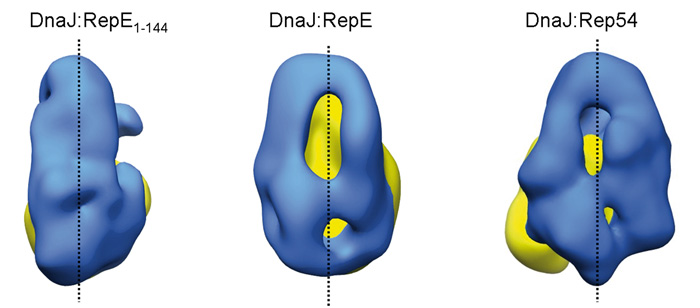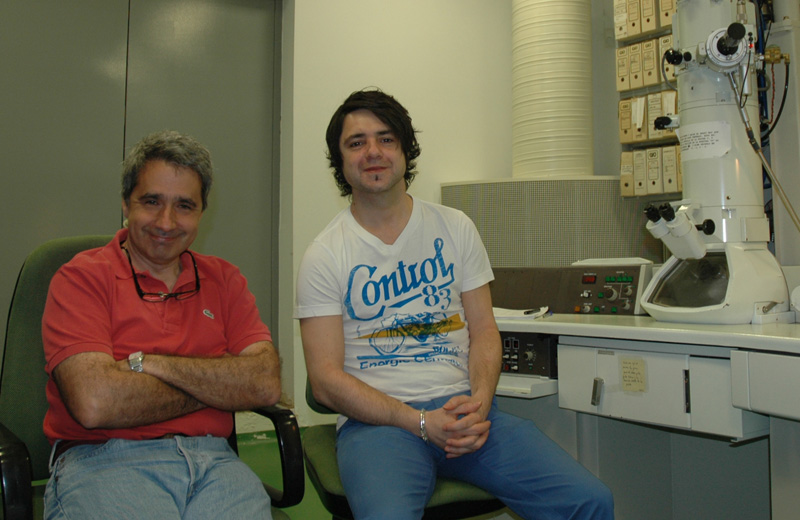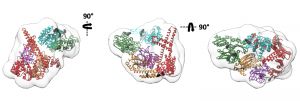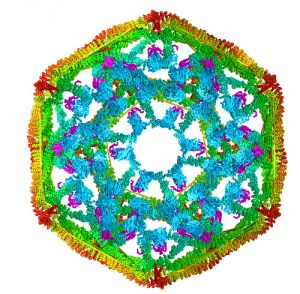- Dos grupos del CNB entre los nuevos proyectos de investigación financiados en la sexta edición de la convocatoria CaixaResearch de Investigación en Salud, promovida por la Fundación ”la Caixa”
- La convocatoria apoya proyectos de investigación básica, clínica o traslacional de excelencia científica y de impacto social en los ámbitos de estudio de las enfermedades cardiovasculares y las infecciosas, en oncología y en neurociencias, así como proyectos que desarrollan tecnologías facilitadoras en estos ámbitos.
La Fundación ”la Caixa” ha celebrado en Barcelona el acto de entrega de ayudas a los 33 proyectos de investigación en biomedicina y salud que se llevarán a cabo en centros de España y Portugal. Se trata de proyectos seleccionados en el marco de la convocatoria CaixaResearch de Investigación en Salud 2023, que tiene el objetivo de impulsar la investigación biomédica de excelencia con gran impacto social en investigación básica, clínica y traslacional. Los grupos de Daniel López Serrano y José María Valpuesta se encuentran entre los seleccionados para desarrollar estos proyectos.
En la ceremonia, que ha tenido lugar en el Museo de la Ciencia CosmoCaixa, el director general de la Fundación ”la Caixa”, Antonio Vila Bertrán, ha recordado: «La investigación científica es fundamental para el progreso social y el bienestar de los ciudadanos. La ciencia no solo nos ayuda a construir la sociedad del conocimiento, sino que es clave para mejorar la calidad de vida de aquellos que más lo necesitan».
La convocatoria, a la que este año se habían presentado 493 propuestas, está especialmente dirigida al abordaje de retos de salud, como las enfermedades infecciosas (ámbito sobre el que se han elegido 8 proyectos), las neurociencias (7), las enfermedades cardiovasculares y metabólicas relacionadas (7) y la oncología (6). Además, otras 5 iniciativas premiadas desarrollarán tecnologías facilitadoras en alguno de estos campos.
La flexibilidad de las chaperonas moleculares, un conjunto de proteínas presentes en todas las células, favorece que actúen en diferentes procesos. Por un lado, ayudan a que otras proteínas recién formadas adopten la estructura tridimensional adecuada para su funcionamiento (plegamiento), pero, por otro, contribuyen a su degradación, un proceso opuesto al anterior, pero también esencial a nivel celular.
Nat Struct Mol Biol. 2016 Aug 1. doi: 10.1038/nsmb.3272
Sousa R, Liao HS, Cuéllar J, Jin S, Valpuesta JM, Jin AJ, Lafer EM
A study conducted jointly by scientists from the United States and Spain shows how Hsp70 chaperones work. As if they were nanomachines, the Hsp70 generate force on other proteins through collisions and stretching, to break bonds between them or transport them through the membranes of different cell compartments.
Del 2 al 4 de abril de 2014 se va a celebrar en el Centro Nacional de Biotecnología del CSIC (CNB) VIII Reunión de la Red Nacional de Estructura y Función de Proteínas.
 Organizada por los científicos del CNB José María Valpuesta y José L. Carrascosa, la reunión pretende reunir a gran parte de la comunidad científica española que estudia distintos aspectos de las proteínas, para intercambiar conocimientos y fomentar colaboraciones. En esta reunión seguirá el formato de las anteriores, con charlas cortas que permitan mostrar los resultados al mayor número posible de investigadores, dando preferencia para las charlas a investigadores junior.
Organizada por los científicos del CNB José María Valpuesta y José L. Carrascosa, la reunión pretende reunir a gran parte de la comunidad científica española que estudia distintos aspectos de las proteínas, para intercambiar conocimientos y fomentar colaboraciones. En esta reunión seguirá el formato de las anteriores, con charlas cortas que permitan mostrar los resultados al mayor número posible de investigadores, dando preferencia para las charlas a investigadores junior.
Para la organización de la reunión se cuenta con la ayuda del Ministerio de Economía y Competitividad y con apoyo por parte del Centro Nacional de Biotecnología y de varias sociedades científicas (SEBBM y SME) y empresas colaboradoras de la Red (Bruker, Sigma-Aldrich y Diffractia). Todo ello ha permitido la invitación de varios científicos que abrirán los simposios de la Reunión (ver Programa provisional).
La asistencia a la reunión será por cuenta de los investigadores participantes, tal como ha ocurrido en anteriores eventos, aunque habrá un número de ayudas a la asistencia para investigadores, financiadas por distintas sociedades científicas, cuyo número y cuantía está aun por determinar.

J Biol Chem. 2013 Jun 7;288(23):16998-7007
Daudén MI, Martín-Benito J, Sánchez-Ferrero JC, Pulido-Cid M, Valpuesta JM, Carrascosa JL.
 During bacteriophage morphogenesis DNA is translocated into a preformed prohead by the complex formed by the portal protein, or connector, plus the terminase, which are located at an especial prohead vertex. The terminase is a powerful motor that converts ATP hydrolysis into mechanical movement of the DNA. Here, we have determined the structure of the T7 large terminase by electron microscopy.
During bacteriophage morphogenesis DNA is translocated into a preformed prohead by the complex formed by the portal protein, or connector, plus the terminase, which are located at an especial prohead vertex. The terminase is a powerful motor that converts ATP hydrolysis into mechanical movement of the DNA. Here, we have determined the structure of the T7 large terminase by electron microscopy.
The five terminase subunits assemble in a toroid that encloses a channel wide enough to accommodate dsDNA. The structure of the complete connector-terminase complex is also reported, revealing the coupling between the terminase and the connector forming a continuous channel. The structure of the terminase assembled into the complex showed a different conformation when compared with the isolated terminase pentamer. To understand in molecular terms the terminase morphological change, we generated the terminase atomic model based on the crystallographic structure of its phage T4 counterpart. The docking of the threaded model in both terminase conformations showed that the transition between the two states can be achieved by rigid body subunit rotation in the pentameric assembly. The existence of two terminase conformations and its possible relation to the sequential DNA translocation may shed light into the molecular bases of the packaging mechanism of bacteriophage T7.
Cuellar J, Perales-Calvo J, Muga A, Valpuesta JM, Moro F.
 Hsp40 chaperones bind and transfer substrate proteins to Hsp70s and regulate their ATPase activity. The interaction of Hsp40s with native proteins modifies their structure and function. A good model for this function is DnaJ, the bacterial Hsp40 that interacts with RepE, the repressor/activator of plasmid F replication, and together with DnaK regulates its function. We characterize here the structure of the DnaJ:RepE complex by electron microscopy, the first described structure of a complex between an Hsp40 and a client protein. The comparison of the complexes of DnaJ with two RepE mutants reveals an intrinsic plasticity of the DnaJ dimer that allows the chaperone to adapt to different substrates. We also show that DnaJ induces conformational changes in dimeric RepE, which increase the intermonomeric distance and remodel both RepE domains enhancing its affinity for DNA.
Hsp40 chaperones bind and transfer substrate proteins to Hsp70s and regulate their ATPase activity. The interaction of Hsp40s with native proteins modifies their structure and function. A good model for this function is DnaJ, the bacterial Hsp40 that interacts with RepE, the repressor/activator of plasmid F replication, and together with DnaK regulates its function. We characterize here the structure of the DnaJ:RepE complex by electron microscopy, the first described structure of a complex between an Hsp40 and a client protein. The comparison of the complexes of DnaJ with two RepE mutants reveals an intrinsic plasticity of the DnaJ dimer that allows the chaperone to adapt to different substrates. We also show that DnaJ induces conformational changes in dimeric RepE, which increase the intermonomeric distance and remodel both RepE domains enhancing its affinity for DNA.
Según se van sintetizando las proteínas en los ribosomas, éstas tienen que ir tomando la forma adecuada para poder ejercer su función. Aunque las características físico-químicas de los aminoácidos que las forman determinan en gran parte la forma que adquieren, hay muchas proteínas que necesitan ayuda extra de parte de un grupo de proteínas conocidas como chaperonas.
 Para comprender mejor cómo funcionan estas proteínas, en su laboratorio del Centro Nacional de Biotecnología del CSIC (CNB), el grupo dirigido por José María Valpuesta ha utilizado la microscopía electrónica. Gracias a esta técnica han podido determinar por primera vez la estructura de un complejo formado por la chaperona DnaJ y su sustrato, lo que les ha permitido observar cómo la chaperona cambia la estructura del sustrato y con ello su función.
Para comprender mejor cómo funcionan estas proteínas, en su laboratorio del Centro Nacional de Biotecnología del CSIC (CNB), el grupo dirigido por José María Valpuesta ha utilizado la microscopía electrónica. Gracias a esta técnica han podido determinar por primera vez la estructura de un complejo formado por la chaperona DnaJ y su sustrato, lo que les ha permitido observar cómo la chaperona cambia la estructura del sustrato y con ello su función.
En colaboración con la Universidad del País Vasco, el investigador postdoctoral del CNB Jorge Cuéllar ha identificado además en dicha chaperona una zona de gran flexibilidad que le permite adaptarse a la forma de distintas proteínas. Como se puede apreciar en la imagen de abajo, la forma que adopta la chaperona DnaJ (en azul) cambia radicalmente en función del sustrato al que se une (RepE1-144, RepE o Rep54; en amarillo). De este modo, una misma chaperona es capaz de unirse a una variedad de proteínas diferentes, consiguiendo en todas ellas que adquieran la forma necesaria para funcionar.

- Cuéllar J, Perales-Calvo J, Muga A, Valpuesta JM, Moro F. Structural insights into the chaperone activity of the 40 kDa heat shock protein DnaJ. Binding and remodeling of a native substrate. J Biol Chem 2013 Apr 11. [doi: 10.1074/jbc.M112.430595].
COOKIES POLICY
A cookie is a text file that is stored on your computer or mobile device via a web server and only that server will be able to retrieve or read the contents of the cookie and allow the Web site remember browser preferences and navigate efficiently. Cookies make the interaction between the user and the website faster and easier.
General information
This Website uses cookies. Cookies are small text files generated by the web pages you visit, which contain the session data that can be useful later in the website. In this way this Web remembers information about your visit, which can facilitate your next visit and make the website more useful.
How do cookies?
Cookies can only store text, usually always anonymous and encrypted. No personal information is ever stored in a cookie, or can be associated with identified or identifiable person.
The data allow this website to keep your information between the pages, and also to discuss how to interact with the website. Cookies are safe because they can only store information that is put there by the browser, which is information the user entered in the browser or included in the page request. You can not run the code and can not be used to access your computer. If a website encrypts cookie data, only the website can read the information.
What types of cookies used?
The cookies used by this website can be distinguished by the following criteria:
1. Types of cookies as the entity that manages:
Depending on who the entity operating the computer or domain where cookies are sent and treat the data obtained, we can distinguish:
- Own cookies: are those that are sent to the user's terminal equipment from a computer or domain managed by the editor itself and from which provides the service requested by the user.
- Third party cookies: these are those that are sent to the user's terminal equipment from a machine or domain that is not managed by the publisher, but by another entity data is obtained through cookies.
In the event that the cookies are installed from a computer or domain managed by the editor itself but the information collected by these is managed by a third party can not be considered as party cookies.
2. Types of cookies as the length of time that remain active:
Depending on the length of time that remain active in the terminal equipment can be distinguished:
- Session cookies: cookies are a type designed to collect and store data while the user accesses a web page. Are usually used to store information that only worth preserving for the service requested by the user at any one time (eg a list of products purchased).
- Persistent cookies: cookies are a type of data which are stored in the terminal and can be accessed and treated for a period defined by the head of the cookie, and can range from a few minutes to several years.
3. Cookies types according to their purpose:
Depending on the purpose for which the data are processed through cookies, we can distinguish between:
- Technical cookies: these are those that allow the user to navigate through a web page or application platform and the use of different options or services it exist as, for example, control traffic and data communication, identify the session, access to restricted access parts, remember the elements of an order, make the buying process an order, make an application for registration or participation in an event, use security features while browsing store content for dissemination videos or sound or share content via social networks.
- Customization cookies: these are those that allow the user to access the service with some general characteristics based on a predefined set of criteria in the user terminal would eg language, the type of browser through which you access the service, the locale from which you access the service, etc.
- Analysis cookies: they are those that allow the responsible for them, monitoring and analyzing the behavior of users of the web sites that are linked. The information gathered through such cookies are used in measuring the activity of web sites, application or platform and for the profiling of user navigation of such sites, applications and platforms, in order to make improvements function data analysis how users use the service.
Management tool cookies
This Website uses Google Analytics.
Google Analytics is a free tool from Google that primarily allows website owners know how users interact with your website. Also, enable cookies in the domain of the site in which you are and uses a set of cookies called "__utma" and "__utmz" to collect information anonymously and reporting of website trends without identifying individual users..
For statistics of use of this website use cookies in order to know the level of recurrence of our visitors and more interesting content. This way we can concentrate our efforts on improving the most visited areas and make the user more easily find what they are looking for. On this site you can use the information from your visit for statistical evaluations and calculations anonymous data and to ensure the continuity of service or to make improvements to their websites. For more details, see the link below privacy policy [http://www.google.com/intl/en/policies/privacy/]
How to manage cookies on your computer: disabling and deleting cookies
All Internet browsers allow you to limit the behavior of a cookie or disable cookies within settings or browser settings. The steps for doing so are different for each browser, you can find instructions in the help menu of your browser.
If you decline the use of cookies, since it is possible thanks to the preferences menu of your browser or settings, reject, this website will continue to function properly without the use of the same.
Can you allow, block or delete cookies installed on your computer by setting your browser options installed on your computer:
- For more information about Internet Explorer click here.
- For more information on Chrome click here.
- For more information about Safari click here.
- For more information about Firefox click here.
Through your browser, you can also view the cookies that are on your computer, and delete them as you see fit. Cookies are text files, you can open and read the contents. The data within them is almost always encrypted with a numeric key corresponding to an Internet session so often has no meaning beyond the website who wrote it.
Informed consent
The use of this website on the other hand, implies that you paid your specific consent to the use of cookies, on the terms and conditions provided in this Cookies Policy, without prejudice to the measures of deactivation and removal of cookies that you can take, and mentioned in the previous section.








